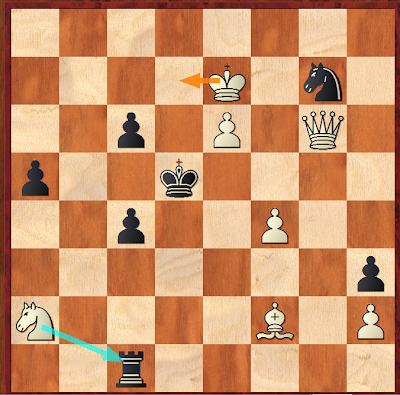We have often commented in this blog about the connection between chess and art, and between chess in Israel and Israel's various wars. Above is a picture of the title page of a boxed set of five booklets
in memoriam of
Yeshayahu "Shaiy" Blaustein (link in Hebrew; using
Jeremy Gaige's English spelling of the name from
Chess Personalia).
Blaustein (1949-1972) was a young architect, who was killed during his military service in a car accident on Dec. 30th, 1972. The fifth booklet is titled, 'chess problems' and has 30 of his compositions. The material is the post below is taken from this boxed set.
A Haifa resident and a Technion graduate, he was part of the group of talented young players who included,
inter alia,
Bleiman. Here is Blaustein (dark shirt on right), looking on at Bleiman (with the white pieces) playing, probably in the Technion's chess club in the late 60s. The booklet has a total of 30 such problems, of many types -- "regular" problems, helpmates, selfmates, maximummers, etc.
He was especially interested in problems that show close relationships between different positions: changed mates and twins.
Yoel Aloni notes he was extremely talented in creating problems with changed play, and adding that he was by far Israel's greatest talent in the late 60s and early 70s -- four prizes and 20 [! - A. P.] honorable mentions in four years.
Below is his most famous problem, which won for him the
Ben-Zion Hendel cup for fairy problems in 1970 (together with other problems), a helpmate from
Al Ha'Mishmar, no. 3086. The "twin" is with Ka3 --> Kc7. Each one of the "twins" has (deliberately of course) two solutions, given at the end of this post.
Blaustein was, apart from being a chess problemist, a talented architect. Like many problemists, his friends say that his main goal -- as an architect, an amateur musician, and a chess problemist -- was a search after beauty. Recalls his father (my translation):
At age 13-14 he began to be interested in chess... and then in solving chess problems, joining the Israeli Problemists' Association and even winning prizes.
One day in 1970 I was called by the head of the problemists' association in Haifa, Mr. Yosef Bierer [ph. spelling -- A. P.] and asked me why Shaiy doesn't come to get his cup. It turns our that he won the national problemists' cup [i.e., the Hendel cup -- A. P.] that year, but didn't come to get it, probably out of shyness or modesty.
'You don't know what a talent you've got', added Bierer.
The Israeli problemist association also published a condolences ad in
Shachmat (Jan. 1973, p. 7) and established a memorial cup in his name.
Solution to above problem (highlight to view):
King on a3:
1. Nxg3 Nxd6 2, Ne4 Nf5#
2. Nxc5 Nxc3 2, Ne4 Ne2#
King on c7:
1. Nxg3 Nxc3 2. Ne4 Ne2#
2. Nxc5 Nxd6 2. Ne4 Nf5#













.jpg)

























